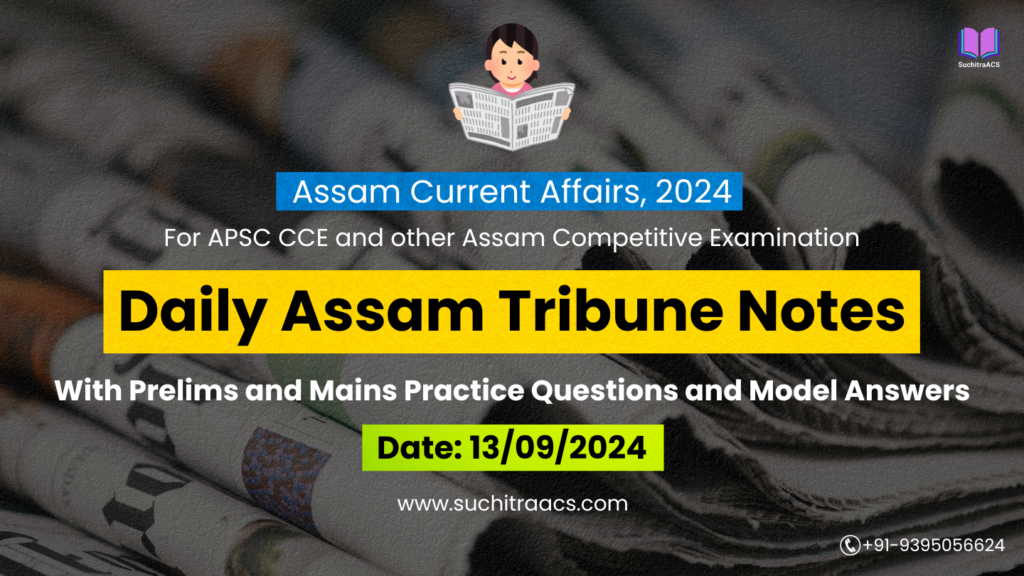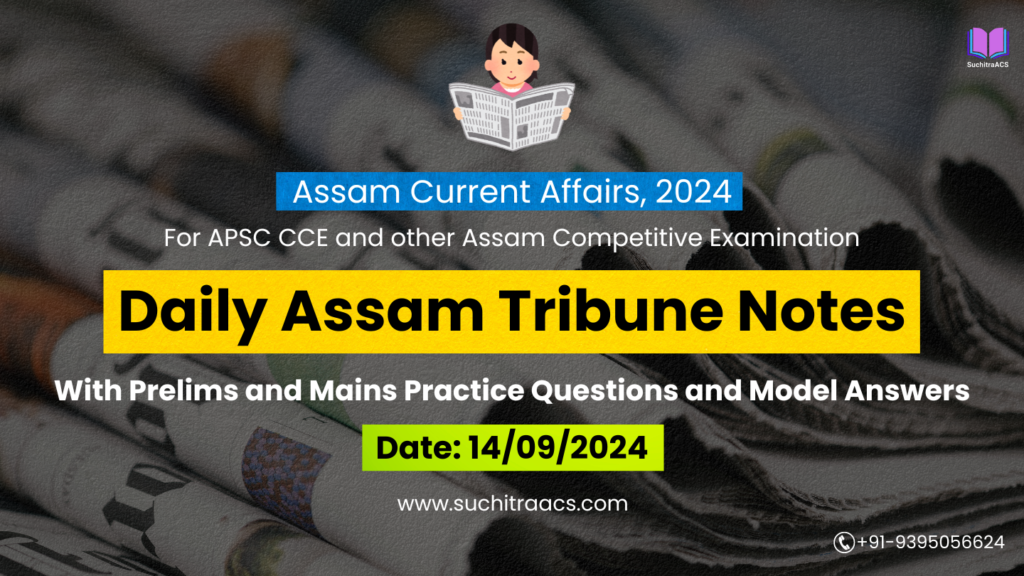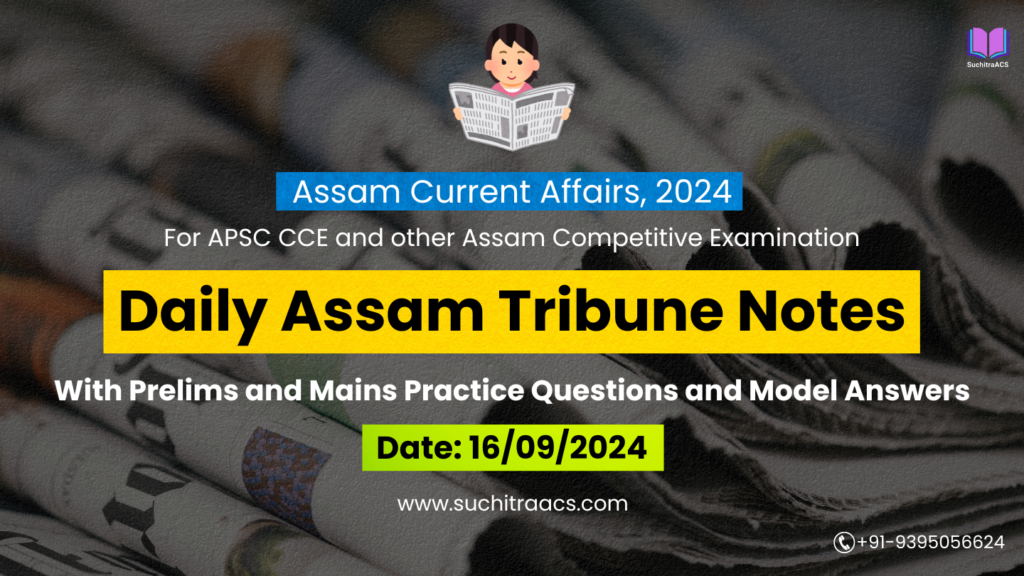APSC Current Affairs: Assam Tribune Notes with MCQs and Answer Writing (01/02/2025)
For APSC CCE and other Assam Competitive examinations aspirants, staying updated with current affairs is vital. This blog covers most important topics from the Assam Tribune today (01-02-2025). These issues are key for both APSC Prelims and Mains preparation, offering insights into the APSC CCE Syllabus.
1. Leprosy Awareness Campaign in Dhemaji
Relevance:
- GS Paper 2: Health & Governance
- GS Paper 3: Social Issues & Awareness Campaigns
Introduction
The Dhemaji district health department has launched a leprosy awareness campaign, running from January 31 to February 13, 2025. The initiative aims to educate communities about leprosy, dispel myths, and ensure early detection and treatment.
Key Points
- Objectives of the Campaign
- Increase awareness about leprosy and its curability.
- Eliminate societal misconceptions and stigma.
- Ensure no leprosy-affected individuals are left untreated.
- Implementation Strategies
- Awareness meetings in villages across Dhemaji district.
- Gram sabhas in 98 Ayushman Arogya Mandirs to mobilize public engagement.
- Community health workers providing door-to-door awareness and screening services.
- Significance of the Theme
- Focuses on inclusivity and social acceptance of leprosy-affected individuals.
- Promotes the importance of early detection and medical intervention.
Prelims Pointers
- Leprosy: A chronic infectious disease caused by Mycobacterium leprae.
- National Leprosy Eradication Programme (NLEP): India’s initiative to eliminate leprosy as a public health issue.
- Ayushman Arogya Mandirs: Primary healthcare centers under Ayushman Bharat providing comprehensive medical services.
- Gram Sabha: A village-level democratic body that facilitates public participation in governance.
Mains Pointers
Significance of Leprosy Awareness Campaigns
- Public Health Improvement:
- Ensures early detection, reducing the spread of the disease.
- Encourages leprosy-affected individuals to seek medical treatment without fear.
- Social Inclusion & Rights Protection:
- Reduces discrimination against leprosy patients.
- Ensures rehabilitation and reintegration of affected individuals into society.
- Strengthening Healthcare Infrastructure:
- Expands the reach of primary healthcare services in rural areas.
- Enhances the efficiency of health workers in leprosy detection and management.
Challenges in Leprosy Eradication
- Social Stigma & Misconceptions:
- Leprosy patients often face ostracization.
- Myths about the disease discourage individuals from seeking treatment.
- Limited Healthcare Access:
- Rural areas lack adequate healthcare facilities for leprosy treatment.
- Shortage of trained dermatologists and leprosy specialists.
- Delayed Diagnosis & Treatment:
- Many cases go unreported due to fear and lack of awareness.
- Advanced-stage cases result in disabilities, making rehabilitation difficult.
Government Initiatives
- National Leprosy Eradication Programme (NLEP):
- Provides free multidrug therapy (MDT) at government health centers.
- Focuses on early detection, treatment, and rehabilitation.
- Sparsh Leprosy Awareness Campaign:
- Community engagement initiative to address social stigma.
- Involves schools, NGOs, and local bodies in awareness activities.
- Ayushman Bharat Scheme:
- Ensures leprosy patients receive financial assistance for medical care.
Way Forward
- Strengthening Awareness & Education:
- Integrate leprosy education into school curriculums and community programs.
- Utilize digital platforms to spread accurate information.
- Improving Healthcare Accessibility:
- Expand telemedicine services for remote consultations.
- Train more medical professionals in leprosy management.
- Policy & Legal Reforms:
- Enforce laws protecting the rights of leprosy-affected individuals.
- Ensure social welfare schemes are effectively implemented.
Conclusion
The Dhemaji leprosy awareness campaign is a vital step toward eradicating the disease and promoting social acceptance. By combining medical outreach with education and policy support, Assam can achieve a leprosy-free society while ensuring dignity and rights for affected individuals.
2. India’s Financial Sector and Economic Growth Projections
Relevance:
- GS Paper 3: Economy, Financial Sector, Capital Markets
- GS Paper 2: Governance, Policy Reforms
Introduction
The Economic Survey 2024-25 highlights that India’s financial sector remains resilient despite global uncertainties. Banking profitability has improved, credit and deposit growth gaps are narrowing, and Initial Public Offerings (IPOs) have surged sixfold between FY13 and FY24. However, challenges such as external demand slowdown, rising protectionism, and inflationary risks remain.
Key Points
- Banking and Financial Sector Performance
- Improved banking profitability due to rising credit demand.
- Credit-deposit growth gap has narrowed, boosting liquidity.
- Capital markets have played a vital role in capital formation and financialization of savings.
- Growth of Indian Capital Markets
- IPOs surged sixfold between FY13 and FY24, driven by young investors.
- Retail and institutional participation in equity markets has expanded.
- Market reforms have enhanced transparency and investor confidence.
- External Trade and Economic Outlook
- Moderate growth in merchandise exports amid a global slowdown.
- Strong imports driven by domestic demand, raising the trade deficit.
- Strategic trade roadmap needed to navigate global trade uncertainties.
- Global Economic Challenges Affecting India
- Rising geopolitical risks and protectionism in international trade.
- Inflationary pressures easing but commodity price volatility persists.
- Need for a resilient economic strategy to sustain 7.5-8% GDP growth.
Prelims Pointers
- Initial Public Offering (IPO): Process through which companies raise capital by issuing shares to the public.
- Credit-Deposit Ratio: Indicates banking sector liquidity and credit expansion.
- Financialization of Savings: Shift of household savings from physical assets to financial assets like stocks and mutual funds.
- Protectionism: Economic policy of restricting imports to protect domestic industries.
Mains Pointers
Significance of a Robust Financial Sector
- Economic Stability and Growth:
- Strengthens investment climate and business confidence.
- Supports credit flow to industries and MSMEs.
- Capital Market Development:
- Encourages entrepreneurship through IPO growth.
- Expands retail investor participation, reducing dependency on foreign capital.
- External Trade and Policy Measures:
- Essential to navigate shifting global trade dynamics.
- Strategic roadmap needed to counter external demand slowdowns.
Challenges to India’s Financial Sector Growth
- Banking Sector Vulnerabilities:
- Rising non-performing assets (NPAs) in certain sectors.
- Need for continuous reforms in governance and risk management.
- Global Trade Uncertainties:
- Slowdown in global demand affecting exports.
- Impact of trade wars and economic sanctions on India’s external trade.
- Inflation and Monetary Policy Risks:
- Need for a balanced approach between inflation control and economic growth.
- Rising commodity prices and interest rate fluctuations pose challenges.
Government Initiatives and Way Forward
- Banking Reforms:
- Privatization of Public Sector Banks (PSBs) to improve efficiency.
- Strengthening bad loan recovery mechanisms under Insolvency and Bankruptcy Code (IBC).
- Financial Market Development:
- Expanding corporate bond markets and digital financial infrastructure.
- Boosting fintech innovation to enhance financial inclusion.
- Export and Trade Policy Adjustments:
- Strengthening Free Trade Agreements (FTAs) with key partners.
- Enhancing export incentives and reducing trade barriers.
Conclusion
India’s financial sector resilience is crucial for sustaining long-term economic growth. Addressing trade challenges, banking sector risks, and inflationary concerns through strategic policy interventions will enable India to achieve its goal of becoming a $5 trillion economy by 2028 and a developed nation by 2047.
3. India’s Economic Survey 2024-25 – Key Highlights & Implications
Relevance:
- GS Paper 3: Indian Economy, Growth & Development, Economic Reforms
- GS Paper 2: Governance, Policy Reforms
Introduction
The Economic Survey 2024-25, tabled in Parliament, provides an in-depth assessment of India’s economic performance and policy recommendations. It highlights key economic trends, growth forecasts, fiscal management, and structural reforms needed to achieve India’s target of becoming a developed nation by 2047.
Key Points
- GDP Growth Projection:
- India’s GDP growth estimated at 6.3-6.8% in FY26, down from 6.4% in FY25.
- Investment-driven growth supported by higher public capital expenditure (capex).
- Need for 8% average growth over the next two decades to achieve developed nation status by 2047.
- Macroeconomic Stability:
- Forex reserves at $640.3 billion, sufficient for 10.9 months of imports.
- Current account deficit (CAD) remains stable amid fluctuating global trade.
- Fiscal consolidation on track, ensuring macroeconomic stability.
- Trade & External Sector:
- Export growth remains moderate due to global demand slowdown.
- Rising protectionism and trade restrictions impacting India’s competitiveness.
- Strategic trade roadmap needed to counter geopolitical risks and integrate with global markets.
- Inflation & Monetary Policy:
- Inflation risks persist due to commodity price volatility and supply chain disruptions.
- Food price stability essential for controlling overall inflation.
- RBI expected to maintain a balanced approach between growth and inflation control.
- Sectoral Growth & Reforms:
- Agriculture: Need for climate-resilient crops and increased pulses, oilseeds, and onion production.
- Manufacturing: India must enhance its global competitiveness through productivity improvements.
- Service Sector: Vulnerable to automation & AI-driven job displacement, requiring workforce upskilling.
- Ease of Doing Business (EoDB) 2.0:
- State governments should lead deregulation and business-friendly reforms.
- Focus on simplification of compliance, tax rationalization, and infrastructure investment.
- Green Energy Transition:
- China’s dominance in renewable energy supply chains poses risks for India’s energy security.
- Investment in solar, wind, and battery storage technologies needed.
- Policy push for domestic manufacturing of clean energy infrastructure.
Prelims Pointers
- Economic Survey: An annual report by the Government of India assessing the country’s economic progress.
- Fiscal Consolidation: A strategy to reduce budget deficits and manage public debt sustainably.
- Forex Reserves: Foreign exchange holdings used to stabilize a country’s currency and trade.
- Ease of Doing Business (EoDB) 2.0: India’s next phase of economic reforms to simplify business operations.
- Current Account Deficit (CAD): A measure of a country’s trade balance, including goods, services, and investments.
Mains Pointers
Significance of Economic Survey 2024-25
- Macroeconomic Stability:
- Reinforces policy continuity and fiscal prudence.
- Ensures a stable growth trajectory amid global uncertainties.
- Investment & Infrastructure Growth:
- Higher public capex supports job creation and economic expansion.
- Strengthening domestic manufacturing to reduce import dependence.
- Strategic Trade & Export Growth:
- Need for diversified export markets to mitigate global demand fluctuations.
- India should leverage free trade agreements (FTAs) for economic expansion.
Challenges Identified in Economic Survey
- Global Trade Disruptions:
- Rising protectionism and geopolitical tensions affect exports.
- Strategic trade partnerships crucial for supply chain resilience.
- Inflation Risks:
- Food and fuel price fluctuations can impact inflation targets.
- Government needs robust policy measures for price stabilization.
- Manufacturing Competitiveness:
- China’s dominance in global supply chains is a major challenge.
- Need for domestic industrial policy to boost local manufacturing.
- Energy Security & Green Transition:
- Heavy dependence on China for solar panels and batteries poses risks.
- India must focus on indigenous renewable energy production.
Government Initiatives & Recommendations
- PLI Scheme: Boosting domestic manufacturing through incentives.
- National Logistics Policy: Strengthening supply chain efficiency.
- Green Energy Mission: Promoting solar, wind, and hydrogen energy projects.
- Financial Reforms: Strengthening banking and capital markets for investment growth.
Way Forward
- Policy Reforms & Deregulation:
- Simplify business regulations and enhance investment climate.
- Diversify Trade Markets:
- Reduce dependence on select nations by expanding trade partnerships.
- Sustainable Growth Strategy:
- Invest in climate-resilient agriculture and renewable energy.
- Focus on Skilling & AI Readiness:
- Prepare for automation-driven workforce shifts in services and IT.
Conclusion
The Economic Survey 2024-25 provides a roadmap for sustained growth, trade expansion, and structural reforms. By addressing global uncertainties, strengthening domestic manufacturing, green energy, and financial stability, India can navigate challenges and achieve long-term economic aspirations.
4. India’s Renewable Energy Transition & China’s Dominance
Relevance:
- GS Paper 3: Environment, Energy Security, International Trade
- GS Paper 2: Global Geopolitics, India’s Strategic Interests
Introduction
The Economic Survey 2024-25 highlights China’s overwhelming dominance in the global renewable energy sector. With over 80% market share in solar panel manufacturing and 60% in wind energy, China’s hold on the green energy supply chain presents a major challenge for India’s energy security and transition. The global green transition is now deeply tied to geopolitical trade conflicts, particularly among China, the U.S., and the European Union (EU).
Key Points
- China’s Dominance in Renewable Energy Manufacturing
- Controls 80% of the solar photovoltaic (PV) supply chain, including polysilicon, wafers, cells, and modules.
- Home to the world’s top 10 solar PV manufacturing firms.
- 60% of global wind energy capacity is sourced from China.
- 80% of the world’s battery manufacturing for electric vehicles (EVs) and grid storage is concentrated in China.
- Investment Trends in Renewable Energy
- In 2022, China invested $546 billion in renewable energy projects.
- This is nearly double the combined investment of the U.S. and EU ($321 billion).
- The 2030 global energy outlook suggests a dramatic rise in solar and wind, with coal and lignite’s share expected to decline sharply.
- Geopolitical Challenges in the Green Energy Transition
- Trade Conflicts: U.S.-China tensions over clean energy supply chains may disrupt global markets.
- Over-reliance on China: India’s renewable energy expansion depends on Chinese imports for critical components.
- Supply Chain Risks: Any disruption in China’s production could severely affect India’s National Solar Mission and EV adoption.
- India’s Renewable Energy Strategy
- National Green Hydrogen Mission: Aims to develop an alternative clean fuel economy.
- PLI Scheme for Solar Manufacturing: To boost domestic solar PV production and reduce import dependency.
- EV Battery Manufacturing Push: Incentives for local lithium-ion battery production to counter China’s dominance.
Prelims Pointers
- Photovoltaic (PV) Cells: Devices converting sunlight into electricity.
- Polysilicon: A key material used in the production of solar panels.
- National Green Hydrogen Mission: India’s initiative for clean hydrogen production.
- Production Linked Incentive (PLI) Scheme: Government support for domestic renewable energy manufacturing.
- Lithium-Ion Battery: The primary technology for EVs and energy storage systems.
Mains Pointers
Significance of Renewable Energy Independence
- Energy Security:
- Reduces reliance on imported fossil fuels and foreign supply chains.
- Enhances India’s self-sufficiency in electricity production.
- Economic Growth & Job Creation:
- Expanding solar and wind sectors can generate millions of jobs.
- Reducing energy import bills will boost GDP growth.
- Climate Change Mitigation:
- Aligns with India’s Net-Zero Emissions 2070 target.
- Helps curb air pollution and carbon emissions.
Challenges to India’s Green Energy Goals
- Dependency on Chinese Imports:
- Over 80% of India’s solar panels are sourced from China.
- Need for domestic semiconductor and battery manufacturing.
- Lack of Technological Expertise:
- India lags behind China in R&D and large-scale production capabilities.
- Strengthening innovation in clean energy technologies is essential.
- Infrastructure Gaps:
- Transmission and storage capacity need upgrades for scaling up renewable power.
- Battery storage systems are expensive and underdeveloped.
Government Initiatives & Strategic Measures
- Renewable Energy Expansion Plans:
- 500 GW of non-fossil fuel capacity by 2030.
- Solar Parks Development Program to accelerate large-scale solar energy adoption.
- Domestic Manufacturing Incentives:
- PLI Scheme for Solar and Batteries to cut import dependence.
- Focus on research & development in battery storage technology.
- Diversification of Energy Partnerships:
- Strengthening ties with U.S., Japan, and EU for alternative technology sources.
- Encouraging joint ventures with global energy firms.
Way Forward
- Boost Indigenous Solar & Battery Production:
- Fast-track domestic PV and battery gigafactories.
- Strengthen Trade Relations with Non-China Suppliers:
- Expand energy collaborations with Japan, South Korea, and EU.
- Accelerate R&D in Green Technology:
- Increase funding for next-generation renewables like hydrogen & advanced batteries.
- Improve Supply Chain Resilience:
- Develop alternative sources for raw materials like lithium and rare earth metals.
Conclusion
China’s dominance in renewable energy manufacturing is a major strategic challenge for India. To achieve energy security and Net-Zero targets, India must diversify supply chains, scale up domestic production, and enhance R&D in clean energy technologies. A strong industrial policy and global partnerships will be crucial for reducing dependence on Chinese imports.
APSC Prelims Practice Questions
1. Leprosy Awareness Campaign in Dhemaji
Q1. Consider the following statements regarding Leprosy:
- Leprosy is caused by a bacterial infection and primarily affects the skin and nervous system.
- The National Leprosy Eradication Programme (NLEP) provides free multidrug therapy (MDT) to patients.
- Leprosy is highly contagious and spreads through direct skin contact.
Which of the statements given above is/are correct?
(a) 1 and 2 only
(b) 2 and 3 only
(c) 1 and 3 only
(d) 1, 2, and 3
Answer: (a) 1 and 2 only
Explanation:
- Statement 1 is correct: Leprosy is caused by Mycobacterium leprae and affects the skin, nerves, and eyes.
- Statement 2 is correct: The National Leprosy Eradication Programme (NLEP) provides free MDT.
- Statement 3 is incorrect: Leprosy spreads through prolonged respiratory droplet exposure, not direct skin contact.
Q2. The “Sparsh Leprosy Awareness Campaign” is an initiative aimed at:
(a) Providing financial assistance to leprosy patients
(b) Addressing social stigma and creating awareness about leprosy
(c) Developing vaccines for leprosy prevention
(d) Providing specialized treatment in urban hospitals
Answer: (b) Addressing social stigma and creating awareness about leprosy
Explanation:
The Sparsh Leprosy Awareness Campaign promotes early detection, treatment, and social acceptance of leprosy patients.
2. India’s Financial Sector and Economic Growth Projections
Q3. What does the “Credit-Deposit Ratio” indicate in banking?
(a) The proportion of total bank deposits converted into loans
(b) The ratio of net bank profits to total deposits
(c) The percentage of total foreign exchange reserves available as liquidity
(d) The amount of cash banks are required to hold in reserves
Answer: (a) The proportion of total bank deposits converted into loans
Explanation:
The Credit-Deposit Ratio (CDR) measures how much of a bank’s deposits are given out as loans, indicating liquidity and credit expansion.
Q4. Which of the following statements regarding Initial Public Offerings (IPO) is/are correct?
- An IPO allows private companies to raise capital by selling shares to the public.
- IPOs contribute to the financialization of savings in an economy.
- The Securities and Exchange Board of India (SEBI) regulates IPOs in India.
Select the correct answer using the codes given below:
(a) 1 and 2 only
(b) 2 and 3 only
(c) 1 and 3 only
(d) 1, 2, and 3
Answer: (d) 1, 2, and 3
Explanation:
- Statement 1 is correct: IPOs help private firms go public and raise funds.
- Statement 2 is correct: IPOs enable household savings to be invested in equity markets.
- Statement 3 is correct: SEBI regulates IPOs in India.
3. India’s Economic Survey 2024-25 – Key Highlights & Implications
Q5. What does Fiscal Consolidation refer to?
(a) Reducing budget deficits and managing public debt sustainably
(b) Merging government and private sector finances
(c) Increasing tax rates to generate higher revenue
(d) Expanding government spending on infrastructure projects
Answer: (a) Reducing budget deficits and managing public debt sustainably
Explanation:
Fiscal consolidation involves reducing budget deficits through revenue generation and expenditure control to maintain economic stability.
Q6. The Ease of Doing Business (EoDB) 2.0 reform focuses on:
(a) Strengthening labor laws for industrial workers
(b) Simplifying regulatory compliance for businesses and investors
(c) Increasing trade restrictions to protect domestic industries
(d) Promoting only large-scale manufacturing companies
Answer: (b) Simplifying regulatory compliance for businesses and investors
Explanation:
EoDB 2.0 aims to reduce bureaucratic delays, streamline tax processes, and enhance investor confidence in India’s economy.
4. India’s Renewable Energy Transition & China’s Dominance
Q7. China dominates the global renewable energy sector by controlling:
- 80% of the solar photovoltaic (PV) supply chain
- 60% of global wind energy capacity
- 80% of the world’s lithium-ion battery manufacturing
Which of the statements given above is/are correct?
(a) 1 and 2 only
(b) 2 and 3 only
(c) 1 and 3 only
(d) 1, 2, and 3
Answer: (d) 1, 2, and 3
Explanation:
China holds a dominant market share in solar PV, wind energy, and battery production, making it a leader in the global green energy transition.
Q8. The National Green Hydrogen Mission aims to:
(a) Promote coal-based hydrogen production in India
(b) Develop alternative clean fuel economies and reduce carbon emissions
(c) Increase import dependence for hydrogen production
(d) Focus only on hydrogen storage and transportation
Answer: (b) Develop alternative clean fuel economies and reduce carbon emissions
Explanation:
The National Green Hydrogen Mission focuses on clean hydrogen production for industrial use, transport, and energy storage, reducing India’s carbon footprint.
APSC Mains Practice Question
Q. India aims to achieve energy security and reduce carbon emissions through its renewable energy transition. However, China’s dominance in the global renewable energy supply chain presents a major strategic challenge. Analyze the implications of this dependence and suggest measures to strengthen India’s renewable energy sector. (250 words)
Model Answer
Introduction
India’s ambitious renewable energy transition aims to achieve 500 GW of non-fossil fuel capacity by 2030 and net-zero emissions by 2070. However, China controls 80% of the global solar photovoltaic (PV) supply chain and dominates wind energy and lithium-ion battery manufacturing, creating supply chain vulnerabilities for India.
Implications of China’s Renewable Energy Dominance on India
- Supply Chain Dependency:
- Over 80% of India’s solar panels and EV batteries are imported from China.
- Disruptions in China’s supply could delay India’s renewable projects.
- Strategic and Geopolitical Risks:
- Trade restrictions and geopolitical tensions can affect India’s energy security.
- High dependence on China weakens India’s bargaining power in global trade.
- Economic Challenges:
- Domestic manufacturers struggle to compete with China’s low-cost production.
- High import bills for clean energy technology increase fiscal burden.
- Impact on India’s Green Goals:
- Dependency on imports slows down India’s transition to clean energy.
- Makes India’s Net Zero 2070 goal more challenging.
Measures to Strengthen India’s Renewable Energy Sector
- Boost Domestic Manufacturing:
- Expand the Production Linked Incentive (PLI) scheme for solar and battery production.
- Establish gigafactories for lithium-ion battery production.
- Diversify Import Sources:
- Strengthen trade partnerships with Japan, the US, and the EU for alternative technology suppliers.
- Encourage joint ventures with global energy firms.
- Invest in R&D & Innovation:
- Increase funding for next-generation solar, wind, and hydrogen technologies.
- Develop indigenous battery storage solutions to reduce dependency on lithium imports.
- Strengthen Infrastructure & Policy Support:
- Implement faster grid modernization to integrate renewables.
- Provide low-interest loans and subsidies for green energy startups.
Conclusion
Reducing dependence on China is crucial for India’s energy security, economic stability, and climate goals. By scaling up domestic manufacturing, diversifying imports, and investing in innovation, India can build a self-reliant and resilient renewable energy sector, ensuring long-term sustainability.
✨ APSC Prelims Crash Course, 2025
at most affordable rate in Assam!

🔔 Join Our WhatsApp Study Group!
For exclusive access to premium quality content, including study materials, current affairs, MCQs, and model answers for APSC CCE and other Assam competitive exams.
Click here to join: SuchitraACS Study WhatsApp Group
📚 Want to know more about SuchitraACS’s most affordable courses?
Click here to know more: SuchitraACS Courses for APSC CCE and Assam Competitive Examinations




